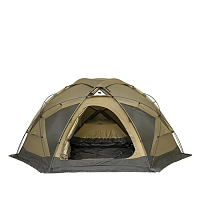Cart
Everything You Need to Know About an Expedition Tent
Expedition tents are the go-to choice for adventurers who embark on challenging outdoor expeditions. These specialized tents are designed to withstand harsh weather conditions, provide maximum protection, and offer ample living space for extended trips in remote locations. In this comprehensive guide, we will explore everything you need to know about an expedition tent, from its key features to the benefits it offers. Whether you're planning a mountaineering expedition or a long backcountry trek, understanding the intricacies of an expedition tent will help you make an informed decision when selecting your shelter.
1. Purpose and Design:
c. Multiple Vestibules: Expedition tents often come with multiple vestibules, providing additional storage space for gear and allowing campers to keep their equipment organized and protected from the elements.
2. Weather Resistance:
c. Snow Skirts and Snow Flaps: Many expedition tents are equipped with snow skirts or flaps at the base. These features create a barrier against snow accumulation, preventing it from entering the tent and maintaining a comfortable living space.
3. Ventilation:
b. Mesh Panels: Some expedition tents have mesh panels on the inner walls or doors. These panels provide additional airflow while keeping insects out. Mesh panels are particularly useful during warmer months or in humid environments where condensation is more likely to occur.
At POMOLY Find the Best Camping Gear for You
4. Size and Weight:
c. Packability: Look for expedition tents that are designed to pack down into a compact size. This feature is particularly important if you'll be carrying the tent in a backpack or on a multi-day trek where space is limited.
5. Additional Features:
c. Guy Lines and Stake Points: Expedition tents are equipped with multiple guy lines and stake points to provide extra stability and secure the tent firmly to the ground. These attachments are crucial for withstanding high winds and ensuring the tent remains taut.
Conclusion:
- Contact Us
-

About Pomoly
Pomoly is a leading camping brand specializing in hot tents and tent stoves. We are camping life explorer, Follow Page / Join Group, let's make camping enjoyful together!
Working Hours
Mon-Fri, 09:00 - 17:00

- Company Info
- NEWS
- About us
- Pomoly Name
- Leave-No-Trace
- Contact Now
- Facebook Group
- YouTube Learning
- Contact Us
- Topic Collections
- Policies & Terms
- Payment Policy
- Shipping Policy
- Return & Refund
- Privacy Policy
- Terms of Use
- Tax Policy
- Website Disclaimer
- Safety Disclaimer
- Warranty Policy
- Promotion Policy
- Pre-order Policy
- INTELLECTUAL PROPERTY RIGHTS
- Dealers Agreement And Terms
- Become Affiliate
- User Center
- Forget Password
- My Orders
- Tracking Order
- My Account
- Register
- Popular Searches
-
Tipi Tents Dome Tents Camping Tent Hammock Stove Camping Camping Pellet Stove Circle 6 Titanium Water TankDome X Locomotive 20 LEO 2 camping tent T-Brick 2.0 T1 2.0 tent stove Dweller wood stove Oroqen 2.0 Chimney Water Tank Lumberjack STOVEHUT Bromance 70 Tipi Pomoly Coupon Baker Oven Stove Titanium elbow Fire Pits Tent Stove titanium Stove Outdoor Pellet Stove
keebon pellet stove






